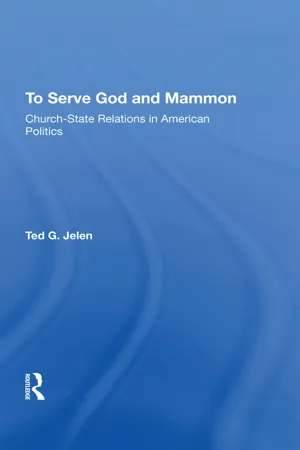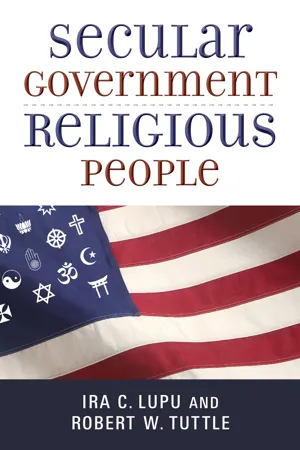Free Exercise Clause
The Free Exercise Clause is a provision in the First Amendment of the United States Constitution that protects individuals' rights to practice their religion without government interference. It ensures that individuals have the freedom to worship and express their religious beliefs without facing discrimination or persecution from the government. This clause has been the subject of numerous legal cases and debates regarding the balance between religious freedom and government regulations.
5 Key excerpts on "Free Exercise Clause"
- eBook - ePub
To Serve God And Mammon
Church-state Relations In The United States
- Ted Jelen(Author)
- 2019(Publication Date)
- Routledge(Publisher)
...Much of the conflict that characterizes religious politics in the United States is attributable to the fact that the Establishment Clause appears to guarantee freedom from religion, whereas the Free Exercise Clause seems to guarantee freedom of religion (Davis 1996). In other words, the Free Exercise Clause allows citizens to hold, act upon, and promote their religious beliefs. In contrast, the Establishment Clause may hold out the promise that such efforts will necessarily be unsuccessful in the realm of politics: A plausible albeit controversial reading of the Establishment Clause suggests that the clause is intended to protect citizens with divergent or nonexistent religious beliefs from the consequences of others’ exercise of religious freedom. The Establishment and Free Exercise Clauses, in offering seemingly contradictory guiding principles, have created a dilemma for judges and other public officials seeking to decide legal and policy questions involving religion. In the last two decades of the twentieth century, political and legal controversies over the public articulation of religion were particularly evident. Even a casual observer could not have missed the mass media coverage of one or another political issue involving the relationship between church and state. Following are just a few examples culled from newspapers: In Republic, Missouri, a lawsuit was filed against the city council, in an effort to have the city’s logo changed. The logo contained, among other symbols, a line drawing of a fish, which opponents claimed was a “secret Christian symbol” dating from the second century A.D. and thus was violating the separation of church and state (Goddstein 1998). In Brooksville, Alabama, the Rev. James Henderson sought the incorporation of his hamlet as a town with the King James Bible as its charter and the Ten Commandments as its ordinances. Rev...
- eBook - ePub
Religion and Politics in America
Faith, Culture, and Strategic Choices
- Allen D. Hertzke, Laura R. Olson, Kevin R. den Dulk, Robert Booth Fowler(Authors)
- 2018(Publication Date)
- Routledge(Publisher)
...Although Protestantism was dominant, free-exercise rights gradually were extended to Catholics, Jews, and others. Of course, in principle such groups could not constitutionally be denied free-exercise rights—yet they faced varying degrees of discrimination that in time gave way to acceptance of the pluralist reality of American religious life. Plenty of constitutional argument and political conflict occurred along the way. Today, Americans generally enjoy a high degree of religious freedom encompassing many religious persuasions, groups, and practices, especially compared with other countries (see Box 12.1). This contemporary freedom does not deny the history of conflict that paved the road to free exercise, nor does it deny that some groups still struggle for their free exercise rights in the United States. There always will be religious groups that push against the margins of American political culture and its written and unwritten rules about the limits of acceptable religious practices. Even some of the largest and oldest religious traditions in the United States occasionally find themselves in conflict with those rules. In attempting to interpret the Free Exercise Clause of the Constitution, the Supreme Court has distinguished between religious beliefs themselves and actions taken as a result of those beliefs. Beliefs are absolutely protected, but religiously motivated action, such as drug use as part of a religious ceremony, may be restricted when the Court decides it contravenes established law. That said, the Supreme Court has avoided addressing religious freedom under some circumstances; indeed, until the 1940s, federal courts often ducked religious issues altogether. For example, courts have been loath to adjudicate arguments among members of disbanded religious groups because getting involved in these often-bitter fights might mean improperly interfering with a religion and thus deterring free exercise. This standard remains today...
- eBook - ePub
The Constitution of the United States
A Primer for the People
- David P. Currie(Author)
- 2010(Publication Date)
- University of Chicago Press(Publisher)
...It may not exclude members of a particular religious community from public service, for such disqualification would indirectly limit religious freedom. 3 Discrimination against dissenting denominations was the central evil the Free Exercise Clause was designed to prevent. 4 Nor may a state exclude from public service persons who do not believe in God. Although the clause speaks only of the free exercise of “religion,” its purpose was to establish a general freedom of conscience; and thus it also protects the right to have no religion at all. 5 The Free Exercise Clause reflects the lesson of the religious wars that racked Europe after the Reformation: without religious toleration there can be no civil peace. Like freedom of expression, however, freedom of religion is not absolute. 6 Even religious conviction cannot justify mutilating women or sacrificing children. This is not to say the amendment protects only belief and not action; the text expressly guarantees the free exercise of religion. As the product of a campaign for religious equality, however, the Free Exercise Clause need not be read to create religious exceptions to general regulations serving legitimate secular goals. 7 Thus the Supreme Court in 1879 held that Congress could forbid polygamy even among Mormons, for whom it was a religious duty. 8 An exception for Mormons, the Justices observed, would not only undermine the public interests underlying the law; it would also give Mormons special privileges solely because of their religion. Similarly, the First Amendment does not exempt conscientious objectors from college military training, Sabbatarians from laws limiting Sunday employment, or soldiers who wear religious caps from military dress regulations. 9 The principle of the First Amendment, these decisions suggest, is neutrality: no one may be either favored or disfavored on religious grounds. Other decisions, however, cannot be reconciled with the neutrality principle...
- Silvio Ferrari, Mark Hill QC, Arif A Jamal, Rossella Bottoni, Silvio Ferrari, Mark Hill QC, Arif A Jamal, Rossella Bottoni(Authors)
- 2020(Publication Date)
- Routledge(Publisher)
...Viewing religion as belief or conscience is recognizably modern and Christian because ‘it emphasizes the priority of belief as a state of mind rather than as constituting activity in the world’ (Asad, 1993 : 47). In this respect, the object of the right to religious freedom is, at its core, a conception of religion understood primarily as ‘a set of beliefs in a set of propositions (about transcendence, causality, cosmology) to which an individual gives assent’. 7 In modern religious freedom jurisprudence, this is the forum internum : the right of the individual subject to ‘have or adopt’ a religion or belief that is considered to be absolutely protected from interference by the law (i.e., is nonderogable and not subject to limitation by the state). 8 Recall again Chief Justice Burger’s statement in Bob Jones University : ‘This Court has long held the Free Exercise Clause of the First Amendment to be an absolute prohibition against governmental regulation of religious beliefs.’ 9 Some version of this proposition is present in all cases arising under the Religion Clauses. 10 Strikingly similar versions appear also in the jurisprudence of the European Court of Human Rights (ECHR) interpreting Article 9(1) of the ECHR. 11 In the American political imaginary, this understanding of religion famously induced Tocqueville to observe that ‘[t]he Americans combine the notions of Christianity and of liberty so intimately in their minds, that it is impossible to make them conceive the one without the other.’ The result was that ‘there are things which religion prevents them from imagining and forbids them to become …...
- eBook - ePub
- Ira C. Lupu, Robert W. Tuttle(Authors)
- 2014(Publication Date)
- Eerdmans(Publisher)
...Part I Civil Government and Religious Institutions Comprehensive works on religion and government tend to start with questions that are at the forefront of the minds of contemporary readers. For questions commonly associated with the idea of a secular government, a series of relatively recent controversies fit that category. Should government be free to sponsor prayer at public events, including graduation ceremonies at schools? What about government display of Christmas symbols in that holiday season, or the congressional choice of In God We Trust as the national motto? The most intense recent controversies about the religious liberty of the people include the mandate that employers insure the cost of contraceptive services for their female employees. Do those who have religious reasons to avoid legal duties have a right under the Free Exercise Clause to exemption from obligations that others must respect? We will address all those matters in due course. But the logic and chrono-logic of our approach to this subject lead us to begin exploring the details in a quite different place. One of the primary functions of government is the resolution of disputes between people. In its role as dispute resolver, the government is normally indifferent to the character of the private parties or institutions involved. Our courts can resolve multibillion-dollar controversies between high-tech giants like Google and Microsoft, as well as everyday matters concerning personal injuries, breaches of contract, employment relations, and the like. However, some disputes that involve religious communities are constitutionally distinctive...




